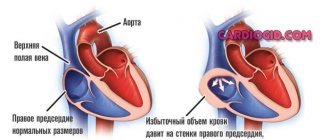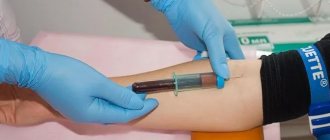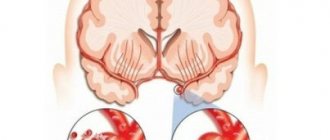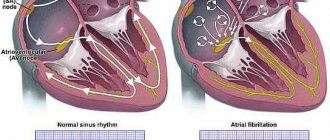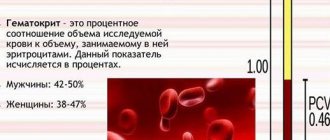- Home >
- Directory >
- Interpretation of ultrasound of the heart
Has your doctor prescribed an ultrasound of your heart?
Or is the echocardiography already over, and the results are in your hands? In order not to miss the pathology, do not try to interpret the ultrasound of the heart yourself. Don’t risk your health, take the protocol to a specialist! If you are interested in what parameters and how the survey results are assessed, refer to this article!
Method for determining the correspondence of heart sizes to human anthropometric parameters
The invention relates to medicine, namely to functional diagnostics, and can be used to determine the individual reserve capabilities of the human cardiovascular system. To do this, measure the patient's height and weight. Then, using nomograms, the body surface area is determined according to previously obtained indicators. Next, the surface area of the heart is determined on the patient's chest x-ray. Then the cardiac cutaneous index (CSI) is calculated as the ratio of the surface area of the human body to the surface area of the heart. When the CSI value is from 70 to 94, the size of the heart is assessed as corresponding to the anthropometric parameters of the subject. If the CSI value is 95 or more, the size of the heart is assessed as inconsistent with anthropometric data. The method provides an accurate individual assessment of the anatomical and functional state of the cardiovascular system in order to determine the subsequent physical activity regimen and predict the risk of developing heart failure. 3 ave., 1 tab.
The invention relates to medicine, namely to cardiology and functional diagnostics, and can be used to determine the individual reserve capabilities of the human heart. To characterize cardiac activity, a study of heart rate, arterial and central venous pressure, skin saturation, etc. is used [Manual on cardiac anesthesiology/ Bunatyan A.A., Trekova N.A., Meshcheryakov A.V. etc. M.: LLC “Med. information agency", 2005; Practical cardiac anesthesiology: (translated from English) Hensley F.A., Martin D.E., Gravley G.P. — 3rd ed. — M.: LLC “Med. information agency", 2008]. These indicators are functional in nature and do not fully reflect the correspondence of the anatomical parameters of the heart to the body weight of the particular subject being studied.
As is known, the pumping function of the heart is determined not only by the heart rate or blood pressure level, but also by the anatomical parameters of the heart, such as the volume of the heart chambers. To determine the total amount of blood pumped by the right and left parts of the heart in the cardiovascular system within one minute, the minute volume of blood circulation (MCV) is calculated. However, when determining the IOC, the individual height and weight characteristics of the person being studied are not taken into account, which is generally represented by the “surface area of the human skin” [Morman D, Heller L. Physiology of the cardiovascular system. - St. Petersburg: Publishing House "Peter", 2000 - 256 p.].
There is a known method for determining the functional state of the left chambers of the heart and the large blood vessels associated with them, including measuring by any known method the durations of the diastolic and systolic phases of the cardiac cycle and calculating, using the formulas of the theory of the “third” mode of fluid (blood) movement, the volumes of blood entering the left ventricle of the heart in the phases of fast and slow filling and systole of the atrium, the volumes of blood expelled from it in the phases of fast and slow ejection, the volume of blood pumped by the ascending aorta, like a peristaltic pump, and stroke volume, and the functional state of this part of the cardiovascular system is determined by the ratio of the calculated volumes [application RU 94031904, published 1996
The prototype of the present invention is a method for determining the functional correspondence of the heart to the body surface area - cardiac index (CI), which is obtained by dividing the value of cardiac output, determined by the thermodilution method, by the size of the skin area: CI = CO / body surface area, where CO is cardiac output (minute volume of blood circulation) in l/min. Normal values of the cardiac index (l/min/m2) are values in the range of 2.6-4.2 [Practical cardiac anesthesiology: (translated from English) Hensley F.A., Martin D.E., Gravley G.P. — 3rd ed. — M: LLC “Med. information agency", 2008; Intensive therapy. Paul L. Marino (translated from English, updated) Editor-in-chief Martynov A.I.]. When determining the SI, in contrast to the IOC, the individual anthropometric data of the subjects are taken into account.
The disadvantage of this method is the complexity of its implementation, the need for catheterization of vessels, as well as a certain inaccuracy of the obtained values associated with the use of data obtained by the thermodilution method.
These methods for studying the IOC and SI do not reflect the anatomical relationship of the heart and body of a particular subject, and also, due to the technical complexity of conducting these studies, cannot be used in an outpatient setting.
As is known, the mass of the heart of an adult is characterized by a certain constancy, with slight deviations in men and women (Avtandilov G.G. Fundamentals of pathological practice. - 2nd edition. - Moscow, 1998. - P. 355). At the same time, the body weight of an adult can vary widely, either on the side of increase, for example with obesity, or decrease (for example, with cachexia), thereby causing deviations in the ratio of a person’s body weight and the size of his heart, or body weight and heart mass. Thus, the ratio of the heart and anthropometric parameters (height, body weight) of the subject may be different and change with changes in body weight and height. Naturally, a sharp discrepancy between the size of the heart and body weight, respectively, the body surface area, can be an anatomical component of heart failure. At the same time, known research methods do not allow registering this ratio and the parameters of its changes, especially since in clinical practice there are no methods for diagnosing heart failure based on assessing the anatomical parameters of the heart and the patient’s body.
The objective of the present invention is to develop a method for determining the anatomical correspondence of the heart to the height and weight of the body or to the “surface area of the human body” being studied, obtaining a formalized indicator of the anatomical relationship “heart - human body”.
The technical result when using the invention is to increase the accuracy of individual assessment of the anatomical and functional state of the cardiovascular system, simplifying the method for use on an outpatient basis.
The proposed method for determining whether the size of the heart corresponds to the anthropometric parameters of a person is carried out as follows. On an X-ray of the chest in a direct projection, using a special ruler, the area of the heart shadow is determined. The next step is to determine the surface area of the subject's body. To do this, use a stadiometer to determine the height of the subject. Body weight is determined by weighing on a medical scale. Next, using the “Du Bois Nomogram for determining the body surface by height and body weight,” the body surface area (m2) of the subject is determined (Bova A.A., Deneshchuk Yu-Ya.S., Gorokhov S.S. Functional diagnostics in practice doctor (guide for doctors) / MIA Moscow, 2007, p. 199). The index of correspondence between heart size and anthropometric parameters - the cardiac-cutaneous index (CSI) is calculated as the ratio of the surface area of a person’s skin to the surface area of the heart according to the X-ray of the subject using the following formula:
KSI=S body surface: S heart,
Where:
CCI—cardiac cutaneous index;
S body surface - surface area of the subject’s body (m2);
S of the heart is the area of the heart shadow on the x-ray of the subject (m2).
When the CSI value is in the range of 70-94, the size of the heart is assessed as corresponding to the anthropometric parameters of the person being examined. If the CSI value is 95 or more, the size of the heart is assessed as inconsistent with anthropometric data.
A study of 28 people was conducted using a blind sampling method. The research results are presented in the table. The range of KSI indicators ranged from 70 to 171.2.
Studies have shown that there is a direct dependence of the value of the skin-cardiac index on the surface area of the human body and the area of the shadow of the heart on an x-ray.
With KSI values of 70-94, the heart size is assessed as corresponding to normal human anthropometric parameters. Indicators of 95 and above indicate “anatomical insufficiency” of the heart in relation to the anthropometric data of the particular person being studied.
The invention is illustrated by the following examples.
Example 1. N., 22 years old. On a chest x-ray in direct projection, the shadow of the heart occupies a small area (0.0084 m2), height 1.60 m, body weight 40 kg, body surface area 1.35 m2. The index of the ratio of body surface area to heart shadow area was 160.7.
Additional information: The patient complains of increased fatigue, shortness of breath with little physical exertion, and episodes of dizziness.
Example 2. M., 25 years old. On a chest x-ray in direct projection, the shadow of the heart occupies 0.0156 m2, height 1.62 m, body weight 90 kg, body surface area 1.94 m2. The index of the ratio of body surface area to heart shadow area was 124.4. Additional information: the patient is concerned about shortness of breath during exercise and episodes of weakness.
Example 3. S., 44 years old. On a chest x-ray in direct projection, the shadow of the heart occupies 0.0240 m2, height 1.72 m, body weight 77 kg, body surface area 1.9 m2. The index of the ratio of body surface area to heart shadow area was 79.2. Additional information: He has no complaints about limitation of physical activity. Physical exercise tolerance is high.
The proposed method for determining the skin-cardiac index makes it possible to determine both the enlargement of the heart relative to anthropometric indicators and excess body weight in relation to the size of the heart. The determination of this indicator can be used to assess cardiac function, based on determining the anatomical ratio “body weight - heart weight” of the subject.
CSI does not affect the area of myocardial dysfunction caused by various pathological conditions (myocarditis, coronary and other heart diseases) and is aimed only at assessing the anatomical aspects of circulatory disorders caused by the correspondence or inconsistency of the heart to body weight in a particular individual.
This method can be used to determine a physical activity regimen or to predict heart failure taking into account body weight, thereby identifying a group at risk for developing heart failure among the population.
Method for determining the correspondence of heart sizes to human anthropometric parameters
| Table | ||||||
| Indicators of height, body weight, body surface area, heart shadow area on an x-ray and their ratio | ||||||
| № | Height | Weight | Surface area | Heart shadow area | Ratio | |
| (cm) | body | patient body (m2) | by x-ray | surface area | ||
| Patient, | (kg) | (m2) | human body to | |||
| age | area of the heart shadow on x-ray | |||||
| 1 | N., 57 | 172 | 93 | 2,09 | 0,0160 | 130,6 |
| 2 | K., 40 | 176 | 73 | 1,90 | 0,0148 | 128,4 |
| 3 | K., 44 | 178 | 78 | 1,95 | 0,0224 | 87,0 |
| 4 | L., 75 | 167 | 65 | 1,73 | 0,0248 | 70,0 |
| 5 | S., 45 | 174 | 76 | 1,9 | 0,0220 | 86,4 |
| 6 | I., 64 | 168 | 75 | 1,85 | 0,0200 | 92,5 |
| 7 | K., 54 | 176 | 70 | 1,85 | 0,0196 | 94,4 |
| 8 | N., 76 | 160 | 55 | 1,55 | 0,0176 | 88,1 |
| 9 | V., 60 | 164 | 74 | 1,80 | 0,0152 | 118,4 |
| 10 | S., 44 | 172 | 77 | 1,9 | 0,0240 | 79,2 |
| 11 | I., 52 | 170 | BY | 2,20 | 0,0220 | 100,0 |
| 12 | P., 65 | 175 | BY | 2,25 | 0,0210 | 107,1 |
| 13 | E., 62 | 166 | 70 | 1,79 | 0,0212 | 84,4 |
| 14 | V., 36 | 170 | 77 | 1,89 | 0,0144 | 131,3 |
| 15 | Ts.,60 | 168 | 87 | 1,97 | 0,0144 | 136,8 |
| 16 | M.,55 | 176 | 84 | 2,00 | 0,0272 | 73,5 |
| 17 | A., 47 | 163 | 75 | 1,80 | 0,0152 | 118,4 |
| 18 | F., 43 | 165 | 100 | 2,05 | 0,0128 | 160,2 |
| 19 | K., 53 | 153 | 63 | 1,60 | 0,0124 | 129,0 |
| 20 | G., 57 | 172 | 90 | 2,25 | 0,0156 | 144,2 |
| 21 | G., 50 | 158 | 70 | 1,71 | 0,0136 | 125,7 |
| 22 | X., 54 | 161 | 60 | 1,61 | 0,0200 | 80,5 |
| 23 | 3., 59 | 168 | 61 | 1,78 | 0,0104 | 171,2 |
| 24 | A., 48 | 164 | 82 | 1,83 | 0,0204 | 89,7 |
| 25 | M., 60 | 154 | 68 | 1,67 | 0,0160 | 104,4 |
| 26 | S., 47 | 162 | 74 | 1,80 | 0,0156 | 115,4 |
| 27 | N., 22 | 160 | 40 | 1,35 | 0,0084 | 160,7 |
| 28 | M., 25 | 162 | 90 | 1,94 | 0,0156 | 124,4 |
A method for determining the correspondence of heart sizes to anthropometric parameters in persons without heart pathology, including determining a cardiac indicator, the surface area of the human body, calculating a conformity index, characterized in that the surface area of the heart is determined as a cardiac indicator using an x-ray, and the skin is calculated as a conformity index. cardiac index according to the formula: KSI = S body surface: S heart, where KSI is the skin-cardiac index; S body surface - surface area of the subject’s body (m2); S of the heart is the area of the shadow of the heart on the X-ray image of the subject (m2), and with an ISI value of 70 to 94, the heart sizes are assessed as corresponding to the anthropometric parameters of the subject, and with an ISI value of 95 or more, the heart sizes are assessed as inconsistent with the anthropometric data.
Normal echocardiogram findings
After completing the procedure, the doctor draws up a cardiac ultrasound protocol, which specifies the size and volume of the chambers, local contractility and blood pumping speed. The table shows the permissible values of cardiac echocardiography in men, women and children, which do not require special attention or treatment.
| Index | Men | Women | Children |
| Thickness of the interventricular septum | 6-10 mm | 6-9 mm | 2-3 mm |
| Thickness of the posterior wall of the ventricle | 6-10 mm | 6-9 mm | 2-3 mm |
| Left ventricular myocardial mass (LVMM) | 65-150 g | 65-150 g | 34-85 g |
| LVM index (takes into account the patient’s height) | 49-115 g/m2 | 43-95 g/m2 | 58-74 g/m2 |
| Ejection fraction | 55-70% | 50-55% | |
| Contractility | not violated | ||
If echocardiography readings deviate slightly from normal, it should be understood that the result may be affected by the person's age and health status. In older people, borderline values are acceptable; they are not always associated with heart disease. In childhood and adolescence, indicators can differ significantly, which is explained by the rapid growth of the child’s body.
Only a qualified doctor can decipher the results of an echocardiogram of the heart with normal or altered indicators, who will explain the situation and prescribe the optimal treatment. To confirm the diagnosis, electrocardiography (ECG), chest x-ray, laboratory blood diagnostics, etc. are additionally performed.
Ejection fraction
Along with other important parameters, an echocardiogram provides data on ejection fraction (EF), which measures the heart's activity during each beat. To understand the danger of deviations in such values, it is necessary to understand what EF is during cardiac ultrasound and why these indicators should not exceed the established norm.
Ejection fraction measures the volume of blood pushed from the ventricle into the blood vessels during one heartbeat. When conducting EchoCG, the ejection fraction of the left ventricle is taken into account, because it is the one that sends blood into the systemic circulation.
Even in a calm state, the heart of a healthy person releases most of the blood from the ventricle into the vessels - the normal EF according to cardiac ultrasound in adults is considered to be 55-70%. A significant decrease in the indicator (less than 40%) indicates the onset of heart failure. With this condition, blue skin, shortness of breath and periodic dizziness are observed.
How is an ultrasound of the heart performed?
First of all, we should consider the classic diagnostic method through the surface of the skin in the chest area (transthoracic). The procedure can be carried out in a hospital or at home - the person undresses to the waist and lies down on a flat surface. After applying the gel to the patient’s chest, the specialist begins the examination, which lasts 15-20 minutes. To decipher an ultrasound of the heart in an adult and draw up a conclusion, it will take an additional 10-15 minutes.
A much less common and more complex method of cardiac ultrasound, which is performed only in a hospital setting, is transesophageal cardiography: the sensor is inserted into the oropharynx and lowered down the esophagus to the required depth. The main advantage of this method is high detail. It is possible to obtain more accurate data than with transthoracic ultrasound of the heart. Transesophageal echocardiography is indicated before surgery to repair heart valves, ruptured aortas, repair heart defects, treat bacterial infections of the heart or valves, or endocarditis.
Preparation for cardiac ultrasound
To conduct a classic ultrasound procedure, no additional preparation is needed - just limit the amount of food and liquid consumed. To obtain undistorted results of Echo CG, the doctor will ask the patient not to drink alcohol the day before the examination and temporarily give up strong tea and coffee. As for the transesophageal examination using a probe, you will have to thoroughly prepare:
- the last meal should be 20 hours before the start of the procedure;
- You cannot drink liquid immediately before an echocardiography;
- if the examination is scheduled for the evening, you are allowed to drink water in the morning;
- the day before the test, you should limit strong physical activity.
The Ultrasound+ clinic invites you to have an ultrasound of the heart at home with a decoding of the indicators and an explanation of whether they are normal. We work in Moscow and the Moscow region, visiting patients’ homes within 1-2 days. It is possible to conduct an urgent ultrasound - then departure is carried out 2-3 hours after the application. The examination is carried out by cardiologists: they immediately interpret the results and, if necessary, draw up a list of further examinations and prescribe treatment.

